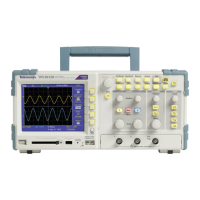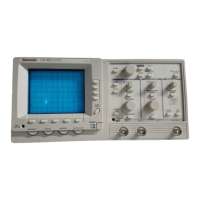Understanding Oscilloscope F unctions
Settings to avo
id aliasing in Sample mode
Time base Samples per second Maximum
2.5 n s
2GS/s
200.0 MHz
5.0 to 250.0 n
s
1GS/sor2GS/s
*
200.0 MHz
500.0 ns
500.0 MS /s
200.0 MHz
1.0 μs
250.0 MS /s
125.0 MHz
2.5 μs
100.0 MS /s
50.0 MHz
5.0 μs
50.0 M S/s
25.0 MHz
10.0 μs
25.0 M S/s
12.5 MHz
25.0 μs
10.0 M S/s
5.0 MHz
50.0 μs
5.0 M S/s
2.5 MHz
100.0 μ
s
2.5 M S/s
1.25 MH
z
250.0 μ
s
1.0 M S/s
500.0 k
Hz
500.0
μs
500.0 kS/s
250.0
kHz
1.0 m
s
250.0 kS/s
125.
0kHz
2.5 m
s
100.0 kS/s
50.0
kHz
5.0
ms
50.0 kS /s
25.
0kHz
10.
0ms
25.0 kS /s
12.
5kHz
25
.0 ms
10.0 kS /s
5.
0kHz
50
.0 ms
5.0 k S/s
2.
5kHz
1
00.0 ms
2.5 k S/s
1
.25 kHz
2
50.0 ms
1.0 k S/s
5
00.0 Hz
500.0 ms
500.0 S /s
250.0 Hz
1.0 s
250.0 S /s
125.0 Hz
2.5 s
100.0 S /s
50.0 Hz
5.0 s
50.0 S /s
25.0 Hz
10.0 s
25.0 S /s
12.5 Hz
25.0 s
10.0 S /s
5.0 Hz
50.0 s
5.0 S/s
2.5 Hz
*
Depending on the oscilloscope model.
Taking Measurements
The oscilloscope displays graphs of voltage versus time and can help you to
measure the displayed waveform.
There are several ways to take measurements. You can use the graticule, the
cursors, or an automated measurement.
34 TPS2000B Series Digital Oscilloscope User Manual

